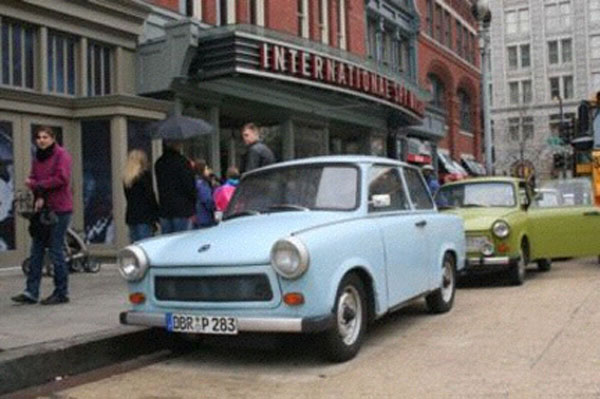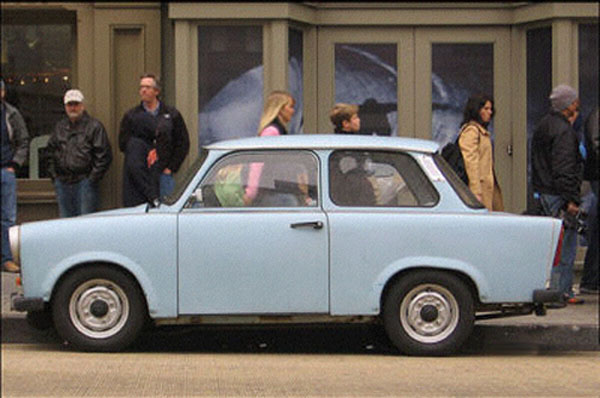TRABANT
Trabant sedan 1974 - Image submitted by Rick Feibusch

Over the years I have become accustomed to paper towels...Paper cups...paper plate, and even paper garments but I never thought I would ever see a paper motor car! However I was wrong...Just a couple of years ago on a visit to Berlin, Germany I saw several. People were renting them out for visitors to joy ride around the city, while at one time they were promoted as being East Germanys answer to the VW Beetle, I am of course referring to the, antique before it was born, vehicle known as the TRABANT.
I use the term paper car as the body was constructed out of resin treated waste paper and various other delights such as wool fibers recycled from discarded garments. The engine, a two cylinder two stroke smoke box produced, at max performance, eighteen horse-powers with a load capacity of four average size adults who could stand the noise from the two stroke power unit that left a trail of black smoke were ever it ventured. The drive train was via the front wheels while the speed on a calm day around forty five MPH however when it rained it was advisable to reduce speed as the vehicle had a tendency to wander due to a primitive type of steering design and the front wheel drive. The car was originally on the drawing board as early as 1956 but the first cars were delivered to waiting customers about five years later.
Trabant sedan 1974 - Image submitted by Rick Feibusch

No matter how bad you may think a car can be there are always one or two good points in the design and/or performance worth writing about...In the case of the TRABANT, even with a sense of fairness, there was nothing justifying such a comment. The two stroke engine was the power source for several 1930's European cars. It was cheap to produce and even cheaper to run as regular service was simple and you could use any acceptable fuel. One of the successful features of the original Peoples Car, the 1937 VW Beetle was the fact that it had a four stroke power unit that had been designed by one of the top engineers of the day yet required very little attention apart from a regular oil change etc. Being air cooled there was no fear of frozen radiators or water leaks, a serious problem in the 1930's as anti freeze was both limited in its protection and expensive.
Production of the TRABANT continued until 1989 but with the unification of both East and West Germany its appeal diminished as East Germany had access to such names as BMW... Mercedes... Porsche and of course the Beetle somewhat improved since its debut in 1937 but still a popular general purpose vehicle. I use that term with no reservations as I have seen VW Beetle Taxies with the front passenger seat removed to accommodate luggage and in certain locations there was an array of cigarettes and or cola on display, offered by the driver as a service to the passengers at an attractive cost. If you could accept the fact that you were buying a car that had no real guarantee of either performance or reliability but was priced to sell then the TRABANT may have been the car for you. With extras like a heater and three speed wipers to cope with the winter conditions you could be a proud owner for just under twelve hundred US Dollars...That's 1960 dollars of course. By 1989 the price had increased by about fifty percent but there was now a color choice!
Today they are collector's items and as I have indicated such a car can be hired for a day or a week should you wish to experience the delights of East German engineering! However take serious heed to my next comment, take a trained motor engineer with you one that knows something about this unique vehicle... (I use the term unique in the broadest sense of the word.) Simply for the experience I drove a TRABANT a few miles and have to say that if I were stranded at the roadside it would be the last car that I would wish to stop and offer a lift to the nearest garage. The engine noise alone reduces conversation to a shouting match while the exhaust manages to share its contents with the passengers as well as the country side.
I only drove for about ten long miles so I can only wonder at the owners who would face the challenge of a forty five kilometer drive or more without stopping for air and the comfort of simply standing up or sitting down in a comfortable chair for a few minutes. I tried to find out how many of these cars were produced but realized that as no formal records were kept apart from figures on a day's production recorded in some note book, the task was difficult. The average buyer had to wait at least a few months from the time of ordering before the car arrived and then could be collected from the state controlled distribution center.
There was a standing joke in East Germany regarding these cars. (A would be purchaser orders a car, delivery time five years. He asked if that would be AM or PM. Why asked the salesman? Reply well my telephone is due to be installed on that date so I want to ensure that someone is home! Following in the footsteps of Mr. Ford you could have any color provided you wanted the color of the car when it arrived for collection. Ownership was restricted, you could only own one car and preference was given to families with children and certain officials who were not high enough in the system to obtain a West German Mercedes, to this scribe the production of such vehicles as the TRABANT for so many years seems at best strange.
The East Germans were trained engineers who could produce a wide range of technical products and had the power and experience of the entire Soviet Block to work with yet the best they could do was to produce a vehicle that it would be hard to give away in most developed countries. However, if you ever get the chance to acquire one do so as they are rapidly becoming a collector's delight.
Geoff Wheatley




BACK TO TOP